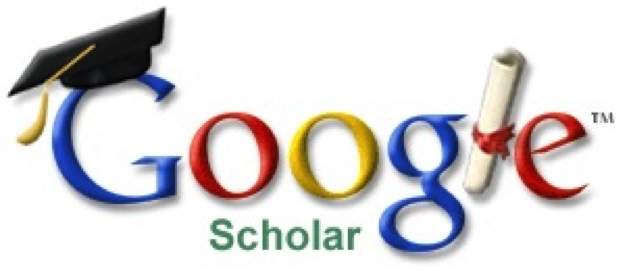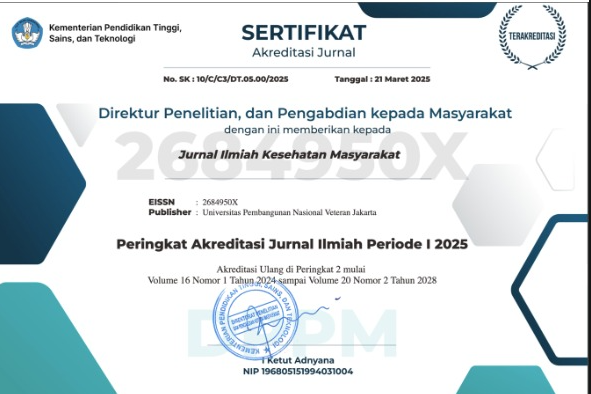Pengaruh Teman Sebaya dengan Status Gizi Lebih Remaja di Sekolah Menengah Pertama di Kecamatan Pamulang
Abstract
Abstrak
Latar belakang: Status gizi lebih atau kegemukan merupakan kondisi terjadinya peningkatan berat badan yang disebabkan karena adanya penimbunan lemak tubuh. Tidak hanya ditemukan pada kelompok usia dewasa, namun status gizi lebih juga ditemukan pada usia anak-anak dan remaja. Prevalensi status gizi lebih pada kelompok usia remaja masih mengalami peningkatan yang tinggi dari tahun ke tahun. Salah satu yang menyebabkan peningkatan status gizi adalah perubahan pola makan. Perubahan pola makan sendiri dipengaruhi oleh adanya peran lingkungan sosial, yaitu pengaruh teman sebaya. Tujuan penelitian ini adalah untuk mengetahui hubungan pengaruh teman sebaya dengan kejadian status gizi lebih pada remaja.
Metode: Jenis penelitian ini adalah observasional dengan desain cross sectional. Sampel diambil menggunakan stratified random sampling dengan jumlah 60 orang siswa-siswi sekolah menengah pertama. Pengumpulan data status gizi dilakukan dengan metode self reported dan untuk pengaruh teman sebaya menggunakan kuesioner pengaruh peer group support. Penelitian ini dilaksanakan pada bulan Juli – November 2020.
Hasil: Hasil anailisis menyebutkan sebanyak 40% remaja tanpa adanya pengaruh teman sebaya memiliki status gizi yang normal dan sebanyak 23,3% remaja dengan pengaruh teman sebaya memiliki status gizi lebih. Penelitian ini menujukkan ada hubungan antara pengaruh teman sebaya dengan status gizi lebih pada remaja dengan p value = 0,028.
Kesimpulan: Pengaruh teman sebaya dapat mempengaruhi terjadinya gizi lebih pada remaja.
The Correlation Between Peer Group Support and Overweight Among Adolescents In Junior High School Pamulang Sub-District Tangerang Selatan
Abstract
Background: Overweight and obesity is a condition in which excess body fat has accumulated and leads to weight gain. Overweight is not only found in adults, but also in children and adolescents. The prevalence of overweight in the adolescent still has a sharp increase from year to year. One of the causes of overweight is changes in diet. Changes in diet are influenced by the role of the social environment, such as peer group support. This research aims to determine the correlation between peer group support with overweight in adolescents.
Method: This research is an observational study with a cross-sectional design. The samples were collected using stratified random sampling, with a total sample of 60 students at middle school. The nutritional status data were collected using the self-respected method, and for the peer influence used questionnaire. This research was conducted in July to November 2020.
Results: The analysis results showed that as many as 40% of adolescents without the peer group support had normal nutritional status, and 23.3% of adolescents with the peer group support had overweight. This research showed that there was a relationship between peer group support and overweight in adolescents, with the p value = 0.028.
Conclusion: Peer group support is able to influence the occurrence of overweight in adolescents.
References
Rimbawan, Siagian A. In deks Glikemiks Pangan. Jakarta: Penebar Swadaya; 2004.
Sugiatmi S, Handayani DR. Faktor Dominan Obesitas pada Siswa Sekolah Menengah Atas di Tangerang Selatan Indonesia Determinant of Obesity among Senior High School Student at South Tangerang Indonesia. J Kedokt Dan Kesehat. 2018;14 No.1:1–10.
Misnadiarly. Obesitas Sebagai Faktor Beberapa Penyakit. 1st ed. Jakarta: Pustaka Obor Populer; 2007.
Sudargo T, Freitag H, Kusmayanti NA, Felicia Rosiyani. Pola Makan dan Obesitas. Yogyakarta: Gadjah Mada University Press; 2014.
Hasdianah, Siyoto S, Peristyowati Y. Gizi Pemanfaatan, Gizi diet, dan Obesitas. Yogyakarta: Nuha Medika; 2013.
Balitbangkes. Riset Kesehatan Dasar. Jakarta; 2013.
Balitbangkes. Riset Kesehatan Dasar. Jakarta; 2018.
Fitzgerald M., Mackie K, Pickel V. The impact of adolescent social isolation on dopamine D2 and cannabinoid CB1 receptors in the adult rat prefrontal cortex. Neuroscience. 2013;235(April):40–50.
Al-sheyab NA, Gharaibeh T, Kheirallah2 K. No Title. J Obes. 2018;2018(September):1–8.
Kocak N, Acikel C, Gulsun M, Istanbulluoglu H, Ozdemir B, Aydemir E, et al. No Title. Psychiatry Clin Psychopharmacol. 2017;27 No.3(July):209–15.
Fatmawati I. Asupan Natrium dan Gula Sederhana sebagai Faktor Risiko Kejadian Hipertensi pada Remaja Awal yang Mengalami Obesitas Di Kecamatan Pamulang Kota Tangerang Selatan. Universitas Gadjah Mada; 2016.
Rosyidah Z, Andrias DR. Sarapan Berhubungan dengan Status Gizi Lebih. Media Gizi Indones. 2013;10 No.1(Januari):1–6.
Nomate ES, Nur ML, Toy SM. Hubungan Teman Sebaya, Citra Tubuh dan Pola Konsumsi dengan Status Gizi Remaja Putri. Unnes J Public Heal. 2017;6 No.3(Juli):51–7.
Gwozdz W, Sousa-poza A, Reisch LA, Bammann K, Lauria F, Eiben G, et al. Peer effects on obesity in a sample of European children. Econ Hum Biol. 2015;18:139–52.
Saifah A. Hubungan peran keluarga, Guru, dan teman sebaya dan media massa dengan perilaku gizi anak usia sekolah dasar di Wilayah Kerja Puskesmas Mabelopura Kota Palu. Universitas Indonesia; 2011.
Keller K. Encyclopedia of Obesity. London: Sage Publications; 2008.
Eveline J.Wouters, Junilla K. Larsen, P.Kremers S, C.Degnelia P, Geenen R. Peer influence on snacking behavior in adolescence. Appetite. 2010;55(August):11–7.
W.Valente T, Fujimoto K, Chou C-P, Spruijt-Metz D. Adolescent Affiliations and Adiposity: A Social Network Analysis of Friendships and Obesity. Author links open overlay panelThomas. 2009;45 No.2(Agustus):202–4.
Fowler JH, Christakis NA. Dynamic spread of happiness in a large social network: longitudinal analysis over 20 years in the Framingham Heart Study. Te BMJ. 2008;1(Desember):1–9.
Arisdanni, Buanasta. Hubungan Peran Teman , Peran Orang Tua , Besaran Uang Saku dan Persepsi Terhadap Jajanan Dengan Kejadian Gizi Lebih Pada Anak Sekolah Relationship between the role of friends , the role of parents , pocket money and perception of snack with overweight inc. 2018;2:189–96.









.jpg)








